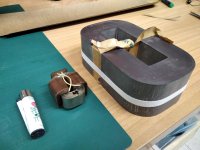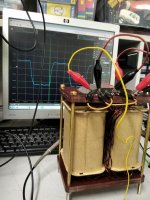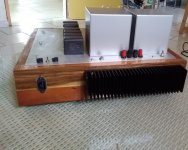Selamat malam, Sumotan !
My wife is chinese, so that's whay the chinese newspaper but also good food...
My wife is chinese, so that's whay the chinese newspaper but also good food...
Last edited:
Nice door stoppers...
Are you going to rewind them?
If so, how ?
@TonyTecson
Will you post images of this progress?
sure thing.....
Ughmmm! Between Lampies519, N101N and Schmitz77 the OP thread has come to a standstill. Why don’t you gentlemen continue this conversation on “The Lounge” thread.
I have read bits and pieces of this thread and come to a similar conclusion. I am an electrical engineer who spent 41 years designing products, some from a mission critical standpoint where a person could lose their life if the radio failed, and some from a cell phone design reality where every penny counts. I also spent the last 14 years in research inventing tech.
Every design project is an exercise in compromise, and it is up to the designer, and the end users to agree on a set of compromises for any given design.
In this case there is not an agreement on what constitutes a "perfect tube amp" so there will be disagreement on what should go in it.
It is possible to design and build a tube with a simple circuit using period correct, or "perfect" components (not the same thing). It may not have great measured specs, but may sound wonderful to a wide listening audience.
It is also possible to design a complicated tube amp with one or more feedback loops that shows good technical performance when measured, and it may sound good to a considerable audience, both are acceptable design methodologies, that will appeal to a different audience.
Both of these approaches are valid to many users, and have been used commercially with successes and failures.
My designs are somewhere in between these two extremes. I will use the correct part to get a particular job done according to good engineering practice. In some applications like a follower or a CCS a mosfet may work better than than a tube due to it's higher Gm. They are useless for other applications due to their poor linearity.
My power supplies may use tubes, silicon, or both, and may or may not use a choke. I tend to avoid "regulators" with active feedback loops as they can be fooled when audio gets applied to their outputs. A simple buffered zener often is the best choice. I don't use GNFB, or any type of feedback that includes the output transformer.
My amps seem to appeal to pretty wide audience. Are they perfect for everybody, no.
....
Stirring things up. Here's my 5K 100W SE OPT on 21sq. cm core 😀
Attachments
https://www.diyaudio.com/forums/att...ngle-stage-driver-c3m-img_20200922_114321-jpg
Do you shoot the less successful pieces with a shotgun? 🙂))
BTW impressive pieces.
Do you shoot the less successful pieces with a shotgun? 🙂))
BTW impressive pieces.
Stirring things up. Here's my 5K 100W SE OPT on 21sq. cm core 😀
i plan to do mine with the coil on just one side of the c-cores...
@euro21, honestly didn't think of it! 😀
Tony, yes, you can. The main advantage of double-bobbin C core audio transformer is the reduced overall MLT, which will slightly reduce Ls, Cs and ohmic losses for the same core. But you get the increased working time of connecting the primary between bobbins.
Tony, yes, you can. The main advantage of double-bobbin C core audio transformer is the reduced overall MLT, which will slightly reduce Ls, Cs and ohmic losses for the same core. But you get the increased working time of connecting the primary between bobbins.
Fixed bias is always an option. I've always used self-bias. I intend to do a bypass cap shootout - want to try some polypropylene caps, some DC Links, some motor runs and some electrolytics.
Has anyone done cathode bypass cap tests for the 300b?
Has anyone done cathode bypass cap tests for the 300b?
What I have desperately been trying to say all along is that to mitigate instability and the harsh, hard, cold, dry, thin, lifeless and soulless pentode sound, stemming primarily from the high amplification factor, it is advisable to go for a high plate current (say,15 mA) and to keep the value of plate resistor and plate voltage at a minimum (say, 150 V), preferably determined empirically.
You can`t increase the amplification factor by reducing the load without increasing distortion and decreasing the bandwidth. That would be getting something for nothing. I find the amplification factor of the C3g to be dreadfully high.
You can`t increase the amplification factor by reducing the load without increasing distortion and decreasing the bandwidth. That would be getting something for nothing. I find the amplification factor of the C3g to be dreadfully high.
There is a mistake, in first time I tried Ec8010. The C3g voltage bias is 2,8v.
EC8010 is better than C3g to this shematic but is microphonic vacuum tube, C3g no and very low hum.
Fixed variable bias is for 300B, VT52. 320B.....
This amplifier run since one year, is stable, no hum, and good sound.
In the first time the PSU is calculate for SPUD EC 8010, E55L and WE437A. Since 2012, 10 SPUD amplifiers run with this PSU, no hum and dynamic.
EC8010 is better than C3g to this shematic but is microphonic vacuum tube, C3g no and very low hum.
Fixed variable bias is for 300B, VT52. 320B.....
This amplifier run since one year, is stable, no hum, and good sound.
In the first time the PSU is calculate for SPUD EC 8010, E55L and WE437A. Since 2012, 10 SPUD amplifiers run with this PSU, no hum and dynamic.
Last edited:
In this shematic, C3g use in triode mode, amplification factor of 40 is just to have 1,7 Veff in.
Amplification factor, gain, efficiency and sensitivity denote the same thing. Electric current, electric charge, capacitance, mass and weight refer to the same thing.
The only way to increase the amplification factor is by reduced mass which inevitably leads to higher instability and closer to resonance transitions. The smaller intrinsic resistance enables larger, higher frequency, poorly damped amplitudes to develop.
The complex external load reduces the magnitude and speed of the driving amplitudes. Although the amplification factor usually plays a decisive role, in the present context, I would not dare to claim that the C3m is more adequate than the C3g.
The only way to increase the amplification factor is by reduced mass which inevitably leads to higher instability and closer to resonance transitions. The smaller intrinsic resistance enables larger, higher frequency, poorly damped amplitudes to develop.
The complex external load reduces the magnitude and speed of the driving amplitudes. Although the amplification factor usually plays a decisive role, in the present context, I would not dare to claim that the C3m is more adequate than the C3g.
I don't use GNFB, or any type of feedback that includes the output transformer.
There's that moment when you think "Oh , maan." when the person being interviewed gives an answer that leads straight to the goods , and the interviewer, instead of asking the only question there is to ask, changes the subject.
Why, George ! Why!!!
- Home
- Amplifiers
- Tubes / Valves
- 300b with single stage driver, C3M or?





